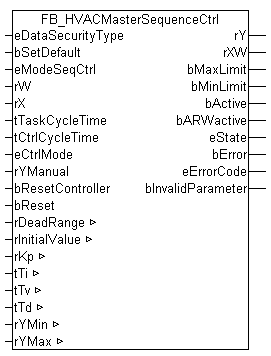FB_HVACMasterSequenceCtrl

Application
Improved controllability can be achieved with the aid of the exhaust air or room temperature cascade control. The master controller measures the room or exhaust air temperature and adapts the setpoint for the supply air temperature to the room conditions. The setpoint for the supply air is limited by a minimum and a maximum value.
In backup mode of the air conditioning system(eModeSeqCtrl = eHVACSequenceCtrlMode_FreezeProtection) the value of rYMaxis switched directly through to the output rY.If overheating protection is active(eModeSeqCtrl = eHVACSequenceCtrlMode_OverheatingProtection) the value of rYMinis switched directly through to the output rY.
VAR_INPUT
eDataSecurityType: E_HVACDataSecurityType;
bSetDefault : BOOL;
eModeSeqCtrl : E_HVACSequenceCtrlMode;
rW : REAL;
rX : REAL;
tTaskCycleTime : TIME;
tCtrlCycleTime : TIME;
eCtrlMode : E_HVACCtrlMode;
rYManual : REAL;
bResetController : BOOL;
bReset : BOOL;eDataSecurityType:if eDataSecurityType:= eHVACDataSecurityType_Persistent, the persistent VAR_IN_OUT variables of the function block are stored in the flash of the computer if a value changes. For this to work, the function block FB_HVACPersistentDataHandling must be instanced once in the main program, which is called cyclically. Otherwise the instanced FB is not released internally.
A change of value can be initiated by the building management system, a local operating device or via a write access from TwinCAT. When the computer is restarted, the saved data are automatically read back from the flash into the RAM.
Application example:  Example_PERSISTENT.zip
Example_PERSISTENT.zip
If eDataSecurityType:= eHVACDataSecurityType_Idle the persistently declared variables are not saved in a fail-safe manner.
Notice | |
A cyclically changing variable must never be linked with the IN_OUT variable of a function block, if eDataSecurityType:= eHVACDataSecurityType_Persistent. It would lead to early wear of the flash memory. |
bSetDefault: If the variable is TRUE, the default values of the VAR_IN_OUT variables are adopted.
eModeSeqCtrl: the plant operation mode is transferred to the controller with the enum eModeSeqCtrl.
rX: acquires the actual value of the control loop.
rW: the setpoint is transferred to the controller with the variable rW.
tTaskCycleTime: cycle time with which the function block is called. If the function block is called in every cycle this corresponds to the task cycle time of the calling task.
tCtrlCycleTime: cycle time with which the control loop is processed. This must be greater than or equal to tTaskCycleTime. The function block uses this input value to calculate internally whether the state and the output values have to be updated in the current cycle.
eCtrlMode: the operation mode is selected via this enum. Manual or automatic operation mode.
rYManual: manual value for the manual operation mode.
bResetController: the internal variables of the PID controller are reset.
bReset: acknowledge input in the event of a fault.
VAR_OUTPUT
rY : REAL;
rXW : REAL;
bMaxLimit : BOOL;
bMinLimit : BOOL;
bActive : BOOL;
bARWactive : BOOL;
eState : E_HVACState;
bError : BOOL;
eErrorCode : E_HVACErrorCodes;
bInvalidParameter: BOOL;rY: temperature setpoint for the supply air temperature controller.
rXW: control deviation.
bMaxLimit: the output bMaxLimit is TRUE, if the output rY has reached the value rYMax.
bMinLimit: the output bMinLimit is TRUE, if the output rY has reached the value rYMin.
bActive: bActive is TRUE, if the controller is active and enabled.
bARWactive: bARWactiveis TRUE, if the integral component of the controller has reached the lower or upper control value limit.
eState: state of the controller. See E_HVACState.
bError: this output indicates with a TRUE that there is an error.
eErrorCode: contains the command-specific error code. See E_HVACErrorCodes.
bInvalidParameter: TRUE if an error occurs during the plausibility check. The message must be acknowledged with bReset.
VAR_IN_OUT
rDeadRange : REAL;
rInitialValue : REAL;
rKp : REAL;
tTi : TIME;
tTv : TIME;
tTd : TIME;
rYMin : REAL;
rYMax : REAL;rDeadRange: in order to avoid unnecessary driving and hence premature wear of the valves or damper drives, a dead range (0..32767) can be set for the controller output signal rY. This means that a control signal change is only active if the change of value is greater than the dead range. A constant change of the control signal rY is converted to a pulsating drive of the actuator if a dead range is specified. The larger the dead range the larger the pauses and the control signal jumps will be. The variable is saved persistently. Preset to 0.
rInitialValue: the restart behavior of the controller is influenced by rInitialValue (0..32767). The variable is saved persistently. Preset to 0.
rKp: proportional factor gain. The variable is saved persistently. Preset to 1.
tTi: integral action time. The I-part corrects the residual control deviation following correction of the P-part. The smaller the tTi time is set, the faster the controller corrects. The control loop becomes unstable if the time is too short. Larger tTi-times must be entered in order to reduce the integration component. The integral action time should be selected to be longer than the stroke time of the valve or damper drive. The variable is saved persistently. Preset to 30 s.
tTv: rate time. The larger tTv is, the stronger the controller corrects. The control loop becomes unstable if the time is too long. Often in normal building automation applications only a PI controller is used. In this case zero must be entered for tTv. The variable is saved persistently. Preset to 0 s.
tTd : damping time. The variable is saved persistently. Preset to 0 s.
rYMin: lower limit of the working range of the controller. The variable is saved persistently. Preset to 16.
rYMax: upper limit of the working range of the controller. The variable is saved persistently. Preset to 25.